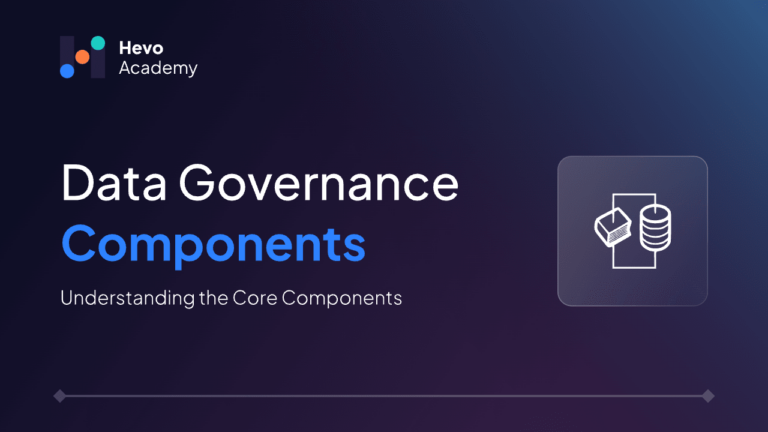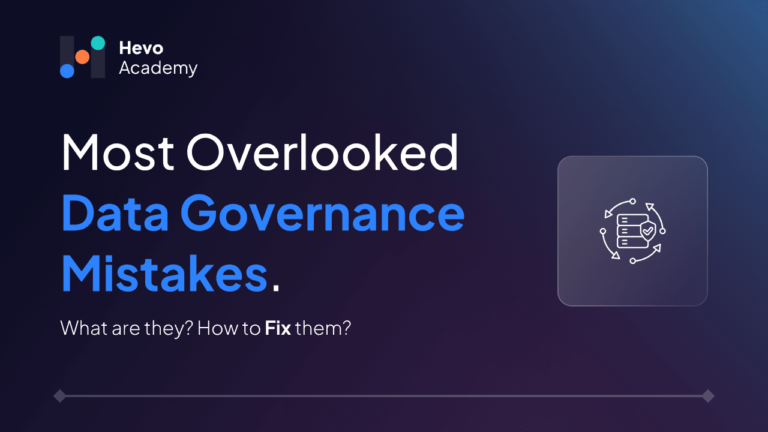Metadata, or “data about other data,” is essential for data management. For instance, metadata describing a blog post includes its author, date, description, language, subject, etc. It provides structured information about data assets, facilitating their efficient use. Metadata can be used for data exploration and search, optimizing storage and retrieval. It’s usually machine-readable, but its value depends on quality, requiring governance.
Table of Contents
Metadata governance ensures reliability, consistency, and security in data-driven systems. It involves developing a data governance plan with standards and procedures for managing metadata throughout its lifecycle. It improves data quality, ensures compliance with regulations, and improves operational efficiency. By promoting the use of standardized schemas and vocabularies, it makes data easier to find and understand, thus improving the efficiency of data search and retrieval. It also makes data more accessible to users through data catalogs, and facilitates complex data integration by systematically mapping metadata from different data sources.
What is Metadata Governance?
Metadata governance can be defined as a system of rules and roles established to manage the information describing data assets. It includes the establishment of policies, standards, methodology (processes) and tools for ensuring the consistency and accuracy of metadata across an organization.
Key Objectives of Metadata Governance
Some of the key objectives of metadata governance include:
- Ensure that data is trustworthy, consistent and complete to enhance data quality
- Make data more accessible and easier to locate
- Align with general data governance policies and procedures to ensure regulatory compliance
- Optimize data usage and improve operational efficiency
- Implement metadata security measures to prevent unauthorized data access or misuse
- Provide the necessary information for making informed decisions
Difference between Metadata Management and Metadata Governance
| Aspect | Metadata Management | Metadata Governance |
| Focus | Technical aspects of creating, storing, and maintaining metadata | Strategic management and control of metadata throughout its lifecycle |
| Scope | Primarily technical implementation and operational tasks | Cross-organizational perspective, including policies, standards, and processes (also in line with data governance) |
| Activities | Data cataloging, metadata creation, metadata quality assurance | Policy development, governance framework establishment, compliance monitoring |
| Roles | Data stewards, data analysts, data engineers | Data governance committee, data owners, data stewards, data analysts |
| Outcomes | Accurate, consistent, and accessible metadata | Improved data quality, enhanced data accessibility, and compliance with data governance policies |
Why Metadata Governance is Critical for Effective Data Governance

Metadata provide valuable information about data assets governed by the overall data governance policies. It is considered the core of data governance, as it provides the information that enables understanding the structure, relationships and the context of data. Based on this information, organizations can establish the overall data governance policies and procedures, specify responsibilities for properly handling data, and ensure regulatory compliance.
Metadata can be represented as a structured record with attributes describing data (e.g. definition, name, purpose, usage, location), which facilitates understanding their context and relevance. These attributes can be stored in hierarchies within data catalogs and indexed to enable efficient search based on specific keywords, thus improving data discoverability. Implementing automated data lineage combined with metadata governance efforts, helps to enhance data traceability and compliance across data ecosystems.
Real-world Examples of How Metadata Governance Supports Business Success
Metadata governance is a valuable component of data-driven systems in various domains. For instance, the financial services industry relies on governed metadata to identify potential frauds or data privacy risks, and comply with financial laws. Manufacturers use metadata to track product components, suppliers, and inventory, optimizing supply chain operations and reducing costs. Metadata also enables e-commerce platforms to provide accurate and relevant search results, improving customer experience and increasing sales.
Core Components of Metadata Governance
1. Metadata Cataloging
Metadata governance relies on building a centralized metadata repository for storing and managing metadata, which acts a “source of truth” for all information about data, and enforces access policies for preventing unauthorized access. This repository must be regularly maintained to keep aligned with changes in the underlying data.
Once built, the metadata catalog enhances the efficiency of locating data for different use cases, as it enables users to easily discover and access required data based on its metadata attributes.
There are several open-source tools available to build metadata catalogs, such as Apache Atlas, Camel and NiFi, but it is also possible to use commercial tools, such as IBM’s Information Governance Catalog or Talend Data Fabric, or even cloud services such as AWS Glue and Azure Data Catalog.
2. Metadata Quality and Standards
Metadata quality and standards aim to establish clear guidelines for managing metadata throughout its lifecycle (creation, storage, and usage) to ensure its consistency and interoperability, and increase its reliability. This includes defining standardized formats, structures and vocabulary for metadata elements, establishing best practices for capturing relevant metadata for particular data assets and adhering to relevant industry-standard metadata formats and data governance policies. It is especially important to establish processes to monitor and assess metadata quality for timely detection of potential issues and inconsistencies.
The established standards and quality guidelines form a comprehensive framework that includes appropriate mechanisms for ensuring metadata consistency, accuracy and completeness.
When building these guidelines, it is recommended to include stakeholders with various backgrounds (from different organization’s departments), ensure that the guidelines are aligned with general business and data-related objectives of the organization, maximally align with existing industry and organization standards, use appropriate tools to automate the process, as well as establish a clear list of common metadata elements across the organization.
3. Metadata Lifecycle Management
Establishing procedures for creating and capturing metadata as soon as data is generated or enters the system, updating and maintaining metadata in line with underlying data changes, and archiving metadata when it is no longer needed, or its retention period expires, is the cornerstone of ensuring its consistency throughout its lifecycle.
The procedures derive from clearly retention periods for metadata specified based on its value, business need, or legal requirements, and the retention policies must be aligned with other data privacy regulations. It is also common to implement a version control system for lineage over metadata and the changes over time according to a specific versioning strategy (date-based, major/minor change-based or other). Once the retention period expires or the value of keeping specific metadata is assessed as insufficient, disposal policies must ensure that it is securely deleted.
4. Metadata Security and Access Control
Similar to data governance, metadata governance also entails implementing security measures to protect (sensitive) metadata to prevent unauthorized access and protecting sensitive metadata by ensuring that metadata is handled and accessed in compliance with data privacy regulations.
Various access control mechanisms such as Role-based Access Control (RBAC), separation of duties and regular security reviews combined with encryption strategy for metadata at rest and in transit are proven strong protection strategies.
Properly securing metadata access helps to build trust that metadata is protected against unauthorized access, and sensitive information is handled responsibly, which stimulates users towards creating metadata.
5. Metadata Integration and Interoperability
Metadata governance establishes a standardized set of metadata schemas and vocabularies to ensure consistency across systems. This also ensures seamless integration of metadata, as we can define mapping rules to ensure their alignment across systems.
Nevertheless, identifying the relevant metadata schemas and vocabularies is no easy task, and it can, therefore, represent a real challenge for interoperability. In large organizations with many source systems, large differences in the meaning and interpretation of metadata elements might lead to inconsistencies and the alignment process might inhibit the data integration.
Still, an effective integration of metadata provides a unified overview of organization’s metadata, making the data assets more accessible to users. Ensuring consistency in metadata definitions reduces errors and facilitates informed decision-making. Having a centralized repository of metadata enables enforcing data governance policies on a single point.
Challenges in Metadata Governance
Some common challenges organizations face when implementing metadata governance include:
- Inconsistent data quality
- Presence of data silos, which can hinder metadata integration from different systems
- Complexity of metadata
- Limited resources (budget, personnel, technical)
- Lack of clear data ownership
- Changing business environment, which makes it difficult to keep the metadata up to date
Poor metadata governance can have a negative impact on data quality and decision-making, as it can lead to inconsistent data interpretations, incomplete or inaccurate data, or outdated data. When decision makers use such data to make business-related crucial decisions, it can lead to business losses.
However, having a strong support from top-level management, regularly running data profiling to identify data quality issues, choosing appropriate metadata management tools and educating employees on the importance of metadata can help mitigate these situations.
Best Practices for Implementing Metadata Governance
It is generally recommended to follow these steps to build a robust metadata governance framework:
- Assess current state of data inventory and metadata
- Define objectives of metadata governance
- Develop metadata standards and policies
- Establish a governance structure to enforce those policies
- Create a data catalog repository with metadata management tools
- Implement access control mechanisms
- Train employees on handling metadata
Do not forget that stakeholder engagement and cross-functional collaboration are crucial for successful metadata governance.
The Future of Metadata Governance
Metadata governance is facing several emerging trends:
- Artificial Intelligence and Machine Learning: leveraging AI and ML for automatic extraction of metadata and semantic meaning of data based on data context
- Blockchain Technology: providing immutable record of metadata for ensuring data integrity
- Cloud-based Metadata Management: using cloud solutions to represent complex relationships between data assets and metadata
- Data Fabric architecture: providing a unified overview of data across an organization for easier metadata management
- Metadata-as-a-Service (MaaS) model: production-ready metadata management service offered to organizations through a given subscription model
Conclusion
Metadata governance is a strategic approach to managing metadata throughout its lifecycle, which describes organization’s data assets. It ensures the consistency, accuracy and accessibility of metadata, often used for informed decision-making. Establishing metadata policies, standards and procedures plays a key role in the overall data governance, especially in terms of regulatory compliance.
Sign Up for a 14-day Free Trial with Us.
FAQ
What is metadata governance?
Metadata governance is a sub-field of data governance, focusing on the control, management and organization of metadata.
What is meant by metadata management?
Metadata management is a set of practices for managing data about data (i.e. metadata).
What is metadata compliance?
Metadata compliance denotes the efforts made to ensure that metadata adheres to data privacy and other relevant standards, policies and regulations.
What are the 4 pillars of data governance?
4 pillars of data governance are data quality (maintaining data consistency and accuracy), data stewardship (ensuring that data policies and procedures are implemented correctly), data protection and compliance (ensuring that data policies are in line with regulations such as GDPR), and data management (managing data throughout its lifecycle).






